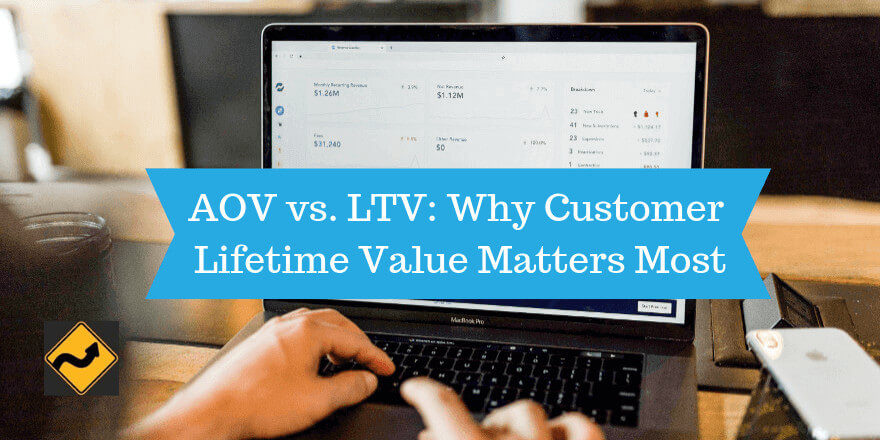Many small business owners — both in eCommerce and traditional retail — make the mistake of focusing solely on short term revenue instead of also considering customer lifetime value (LTV).
“Many entrepreneurs find themselves in a race to the bottom, as they begin to focus on using revenues to keep up with expenses instead of produce profits,” writes Eric Siu at Entrepreneur.
The misguided focus is understandable. After all, revenue is what keeps your business afloat.
As a result, many eCommerce owners will focus on bundling, upselling, free shipping and other incentives to boost their average order value (AOV).
But boosting profitability is what will help you grow your business. And to boost profitability in the long term, you need authentic and long lasting connections with your customers.
This is where a renewed focus on your customers’ lifetime value will become invaluable.
Average Order Value: A Short Term Boost of Revenue
Average order value as a number is straightforward: the total revenue divided by the number of orders for your eCommerce business.
AOV is a good metric to start with as you begin exploring new routes of acquisition and upselling.
After all, the higher your order value, the fewer customers you need to acquire. At the same time, in the short term, it gives you more to work with. Higher revenue means more advertising dollars.
But focusing solely on AOV can be limiting. It not only fails to take into account cost of goods and other expenses; AOV also limits its view to month-by-month improvements, rather than lending itself to long term growth.
Lifetime Customer Value: A Long Term Boost of Profitability
In contrast to AOV, increasing the lifetime value of a customer takes a much larger and long term view of profitability.
To accurately calculate LTV for your eCommerce brand, you need an accurate view of all costs associated with each order: shipping, cost of goods sold, processing fees, and an average refund rate.
Take that net revenue and multiply it by the customer’s annual purchase frequency and you have customer value.
You can then multiply that customer value by the average customer lifespan — typically no more than 1 to 3 years for an up-and-coming eCommerce brand.
Even with this limited definition, you can see that AOV and LTV are closely related. Order value affects customer value, which affects lifetime value of the customer.
The main difference in increasing LTV versus AOV is that lifetime value efforts are focused on organic changes to your interactions with customers.
AOV vs. LTV: Determining How They Work Together
Utilizing AOV and LTV is not necessarily an either/or approach to metrics, whether you are a small business or major eCommerce enterprise.
If, up to this point, you have focused solely on increasing the value of each order, you should have a good foundation for marketing tricks like upselling, bundling and shipping.
And if you have focused on building up a loyal customer base, you most likely have a good start on personalization and creating authentic customer connections.
The key is to bring AOV and LTV together as you grow, since both contribute to your profitability in the long term.
As you grow your small business into a full-fledged eCommerce brand, you’ll need to incorporate both AOV and LTV into your marketing mix. Here are a few tips for hitting the high points.
5 Tips to Maximize LTV for Your eCommerce Brand
If you’re running a successful eCommerce business (with the loose definition of ‘success’ as ‘in the black’), you most likely already have tricks for boosting AOV dialed in.
But what about giving your profitability a long term boost?
- Make brand loyalty a primary business goal. Keeping customers around shouldn’t be an afterthought in the wake of a sale. It should come first.
- Make marketing channels more valuable. Use personalization tools, automated outreach, drip campaigns, targeted social ads and more. They should be streamlined for you and valuable for your customers.
- Make customer service a business pillar. Close the loop on customer feedback, utilize your customer’s voice in your marketing materials and place CX right on top with product.
- Make customer transactions easy. An easy checkout process will boost AOV and an easy account creation process will boost LTV.
- Make use of your customer data. As an eCommerce business, you have customer data at your fingertips. Put it to use! Every ad, email, special offer and product price point should be based on data.
Get Creative with These Tips
You don’t want your marketing efforts to feel like marketing to current customers. Instead, they should add value to their interactions with your brand — birthday wishes and special offers come to mind.
Consider implementing a knowledge base, for example, to offer valuable content and ease your customer service load.
In the same way, personalization doesn’t just mean tweaking landing pages according to customer data. It also means marketing to current customers based on a customer lifecycle management strategy:
“Using CLM, you can create the kind of communication that is personally meaningful to your customer.”
Long story short: thoughtful small business marketing strategy is at the heart of increasing both AOV and LTV for your eCommerce business.
Even if customers love your products, you’ll only hit that sweet spot of a high AOV and sustainable LTV by putting in the effort to continually bring value to your customers.

